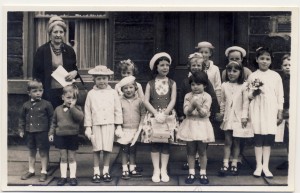One of the most useful mental disciplines eight years on the Competition Commission taught me was to make assessments (of whether a merger would lead to a significant lessening of competition, in that context) against a specific counterfactual. In other words, compared to what, exactly? Often the answer was the status quo, but it was important to be explicit about that given people’s natural tendency to compare likely outcomes to an ideal world.
Emma Griffin’s fascinating book [amazon_link id=”0300151802″ target=”_blank” ]Liberty’s Dawn: A People’s History of the Industrial Revolution[/amazon_link] is explicit about her counterfactual. She uses her study of 350 19th century autobiographies (some published, some not, mainly by men, almost all born in poverty), supplemented with research in parish registers and other sources to ask: how did the lives of working people in Britain change between the late 18th and late 19th centuries? How did the misery of early industrial cities compare with the way these writers had lived in earlier decades?
The answer challenges the standard account of the impact of the Industrial Revolution on working people. As Griffin notes, there is an unbroken line from Friedrich Engels’ [amazon_link id=”0199555885″ target=”_blank” ]The Condition of the Working Class in England[/amazon_link] through Toynbee and the Webbs to E.P.Thompson’s [amazon_link id=”0140136037″ target=”_blank” ]The Making of the English Working Class[/amazon_link] painting the economic changes as an entirely immiserizing process. “Thompson produced an extraordinarily powerful restatement of the dark and bleak interpretation,” she writes. “The only difficulty is that the autobiographies, those rare and unique records in which the labouring poor retold their stories, refuse to co-operate.”
Their lives were complex and difficult, she notes. There are no standard narratives. They do not pretend their work to have been easy or enjoyable – on the contrary. “Yet repeatedly our writers tell is that work in cottage industries, factories, mines, warehouses, large cities and construction was better than the labour that had consumed their fathers’ energies, and often their own early labour as well.” The main message of the book’s exploration of the source material is the increase in opportunity brought by urbanisation and industrialisation. The first batch of chapters describe the various experiences of the autobiographers, the second set explore themes such as marriage and sex, and education.
The education chapter emphasises the most the steady expansion of opportunity. At the start of the 19th century the only access any poor children had to education was in local dame schools, informal, paid for on occasional days when there was little farm work to be done, although for some of the individuals a powerful autodidactic drive was evident, and some were assisted by better off neighbours or employers who provided books or paper and pen. As the century progressed, education was gradually institutionalised and extended – Sunday schools, Mechanics’ Institutes, circulating libraries with cheaper subscriptions, and so on. This is the territory explored in Jonathan Rose’s wonderful book, [amazon_link id=”0300098081″ target=”_blank” ]The Intellectual Life of the British Working Classes[/amazon_link], but here told in terms of the impact on the lives of the autobiographers. Interestingly, a number gained status and confidence themselves through teaching – for example, as Sunday School teachers, in these voluntary schools. Griffin writes: “In working class eyes, the position of Sunday School teacher carried status.” This was still true in my childhood in the 1960s and 70s, in a Northern, largely non-conformist, mill town.

My Sunday School teacher, at the back, was a respected figure. Guess which child in this 1960s Whit Sunday church procession is me.
[amazon_link id=”0300151802″ target=”_blank” ]Liberty’s Dawn[/amazon_link] does a real service in reviving the voices of working class people who lived the Industrial Revolution. I’m sure it won’t overturn the traditional dismal account of misery – one can point out for example that people who succeeded to the point of being able to commit a memoir to paper were probably exceptional. But it’s a terrifically interesting read. My one quibble is that the author has a number of academic tics in her writing style, and it could have been an even more approachable book – but that’s to compare it to the wrong counterfactual.
[amazon_image id=”0300151802″ link=”true” target=”_blank” size=”medium” ]Liberty’s Dawn: A People’s History of the Industrial Revolution[/amazon_image]




